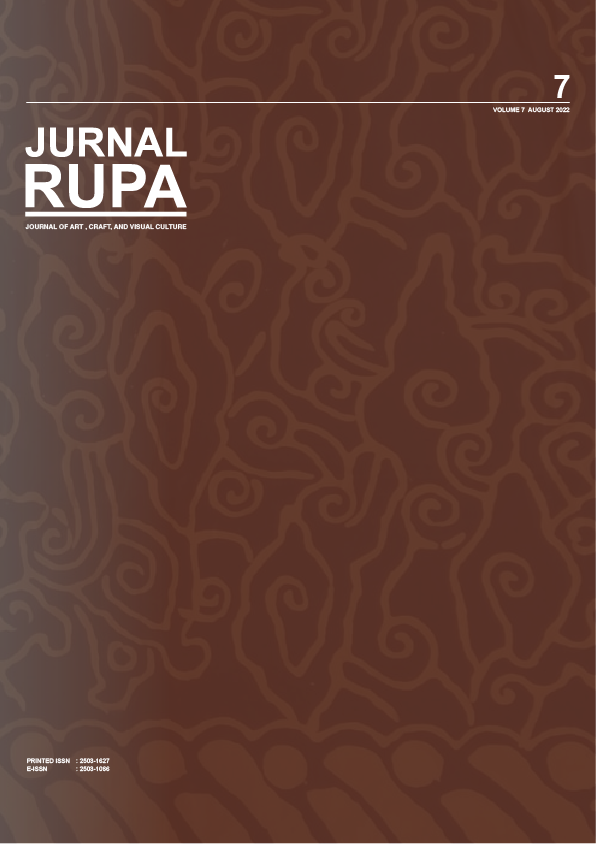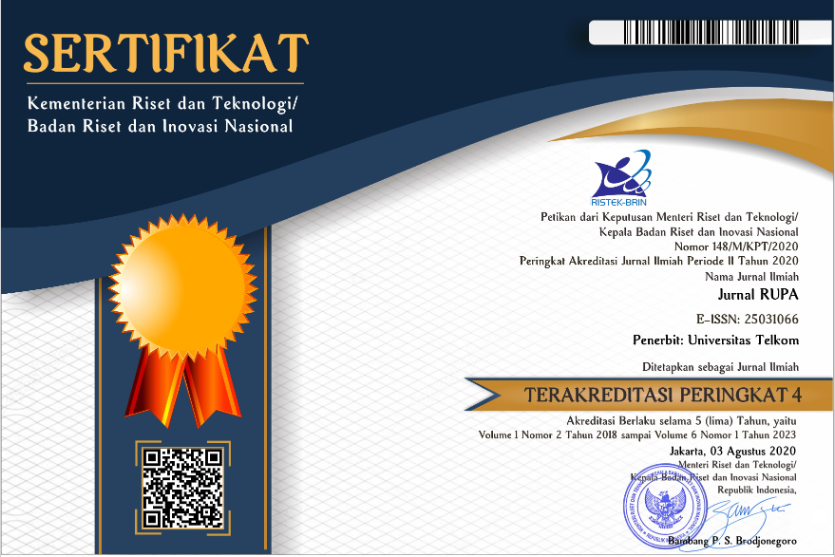Perancangan Busana Uniseks Bergaya Co-Ed Androgynous Berbasis Konsep Sustainable Fashion
DOI:
https://doi.org/10.25124/rupa.v7i1.4823Keywords:
Upcycle Design, Unisex, Co-ed Androgynous, Gender Fluid, SustainableAbstract
Covid-19 pandemic resulted many changes and adjustments in various sectors of life, including the creative fashion industry sector. One of the topics that came out was the concept of sustainable fashion as a solution to overcome the challenges of changing times. One of the ideas for implementing the concept is “reduce-reuse-recycle”. The topic of this research is the application of the reduce-reuse-recycle concept in the design of co-ed androgynous unisex fashion using clothing waste, unsold clothing stock, and leftover fabric scraps. The topic of unisex clothing is a global fashion trend phenomenon that represents the efficiency of product differentiation as well as a gender identity campaign through appearance. The research problem is to find a suitable concept of design development for a unisex fashion product with co-ed androgynous style based on sustainable. The purpose of the research is to determine the concept and process of designing a unisex fashion product with a co-ed androgynous style based on a sustainable concept. The research method uses descriptive qualitative methods through triangulation (combined) data collection techniques covering several ways, namely literature, observation, interviews, and experimental. The design method uses the DUCMOT fashion system design stage with the design process in research and experimental testing. This concept not only has a positive impact on the surrounding environment but can also hone the creativity of industry players in utilizing and extending the life cycle of a product into new, innovative products.
Keywords
Co-ed Androgynous, Gender Fluid, Sustainable Fashion, Unisex, Upcycle Design
Downloads
References
. Harbet, Parlin., Sembiring, Sanika. 2020. Analisis manajemen krisis Zara Fashion di Masa Pandemi Covid-19. Jurnal Public Relation. 1. 2. https://doi.org/10.31294/jpr.v1i2.497
. Rizal, Jawahir Gustav. 2020. Dampak Pandemi Corona, Penjualan Fashion Mewah Dunia Turun 650 Miliar Dollar AS. Kompas.com.
. Febrinastri, Fabiola. 2021. Akibat Covid-19 Penjualan Fesyen Indonesia Turun 70%, Ini Upaya Kemnaker. Suara.com.
. Khandual, A., Pradhan, S. 2019. Fashion Brands and Consumers Approach Towards Sustainable Fashion. In: Muthu, S. (eds) Fast Fashion, Fashion Brands and Sustainable Consumption. Textile Science and Clothing Technology. Springer, Singapore. https://doi.org/10.1007/978-981-13-1268-7_3
. CINI, Cigdem Asuman. 2019. An Upcycling Project In Textile And Fashion Design. The Research Journal of the Costume Culture. 27. 1: 11-19. https://doi.org/10.29049/rjcc.2019.27.1.011
. Shaikh, F. N. 2021. The Impact of Sustainability on Fashion Industry. Journal of Business Strategies. 15. 1: 45-58. DOI:10.29270/JBS.15.1(21).03
. Sung, Kyungeun., Cooper, Tim., Oehlmann Johanna., Singh, Jagdeep., Mont, Oksana. 2020. Multi-Stakeholder Perspectives on Scaling up UK Fashion Upcycling Businesses. Fashion Practice. 12. 3: 331-350. DOI: 10.1080/17569370.2019.1701398
. Chuma, Chipo., Muza, Tariro., Chipambwa, Walter. 2019. An Examination of the Upcycling Design Process of Used Clothes among Fashion Design Students: Towards an Approach for Sustainable Fashion Design Practice. International Journal of Costume and Fashion. 19. 2: 59 – 69. DOI : 10.7233/ijcf.2019.19.2.059
. Aus, R., Moora, H., Vihma, M. et al. 2021. Designing For Circular Fashion: Integrating Upcycling into Conventional Garment Manufacturing Processes. Fash Text. 8. 34. https://doi.org/10.1186/s40691-021-00262-9
. Hur, Eunsuk., Cassidy, Tom. 2019. Perceptions and Attitudes towards Sustainable Fashion Design: Challenges and Opportunities for Implementing Sustainability in Fashion. International Journal of Fashion Design, Technology and Education. 12. 2:208-217. DOI: 10.1080/17543266.2019.1572789
. Pham, V. T., Xuan, V. T., Trang, N. M., Hang, P. M. T., & Nguyen, N. T. 2021. Factors Affecting Young Consumers’ Intention to Purchase Upcycled Fashion Products – A Case Study in Vietnam. Journal La Bisecoman. 2. 4: 40-54. https://doi.org/10.37899/journallabisecoman.v2i4.458
. Sumerau, J. E., Mathers, L. A. B., & Moon, D. 2020. Foreclosing Fluidity at the Intersection of Gender and Sexual Normativities. Symbolic Interaction. 43.2: 205–234. https://doi.org/10.1002/symb.431
. Pambudi, N. S. H., Haldani, A., & Adhitama, G. P. 2019. Studi Preferensi Masyarakat Jakarta Terhadap Genderless Fashion. Jurnal Rupa. 4. 1: 54. https://doi.org/10.25124/rupa.v4i1.2249
. Lee, J.-E., & Kwak, T.-G. 2020. Study on Gender-Neutral Style in Modern Fashion. Journal of the Korea Fashion and Costume Design Association. 22. 3: 111–126. https://doi.org/https://doi.org/10.30751/kfcda.2020.22.3.111
. Paolleti, Jo B. 2015. Unisex; Fashion, Feminism, and the Sexual Revolution. Indiana University Press. Bloomington Indiana USA.







